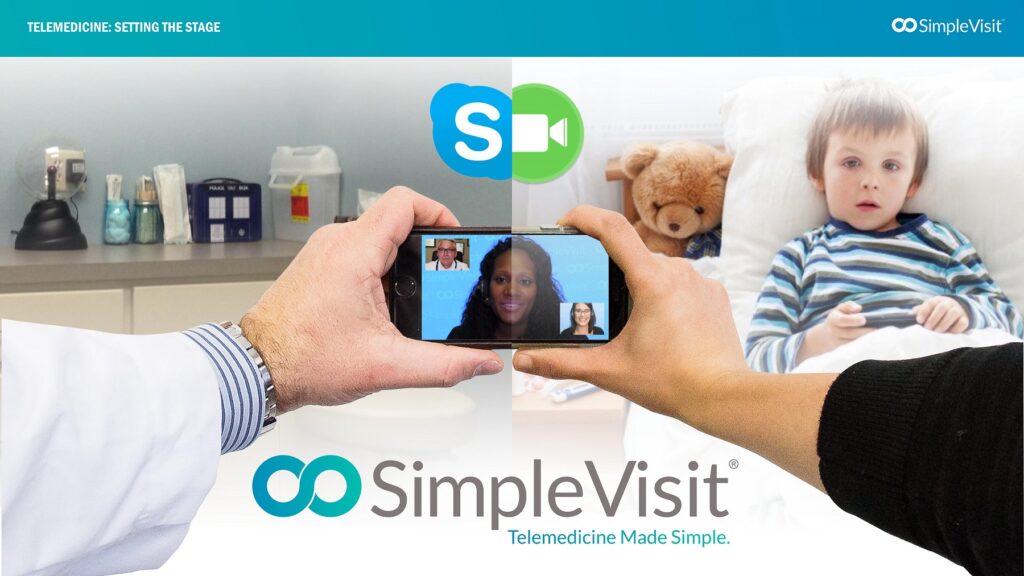This article is designed to help practices determine the most ideal vendor and technology for their telemedicine program. With over 700 telemedicine solutions on the market, it can be a daunting task for practice administrators and IT managers to filter down to the best option for their patients and providers. The information below can be a guide for your team regarding procurement and best practices when launching a telemedicine program. These considerations will help your practice put its best foot forward, ensure a good experience for your patients and streamline the workflow for your providers and staff.
PEAKE Technology Partners has been helping our clients navigate tech solutions for telemedicine as part of our full suite of services for the past 5 years. We have produced a proprietary solution and now partner with SimpleVisit, a managed Telemedicine service helping medical groups connect to patients in the best user-experience humanly possible. You can learn more about this option at simplevisit.com.
Before you search
We have witnessed many telemedicine programs fail or remain unused, not because of the technology used, but due to a breakdown in workflow. It is crucial for the sustainability of your program that you consider the telemedicine use case, workflow, and stakeholders even BEFORE you shop for tech to fit your needs.
The use case is central to everything else that follows. If you have not already, determine all of the desired uses for telemedicine video visits. It is advised to get feedback from your clinical staff and write it out. Options for video visits usually center around:
- Triage – assessments prior to an on-site visit or predetermination for next steps.
- Consultations – care and instruction that typically would not require the taking of vitals.
- Follow Ups – going over lab results, medication management, or check ins are common uses for video visits.
Once the use case scenarios are listed, then you should determine how adding video visits affects your existing workflow. Questions to ask here would be, “Will the patient be able to initiate or request a video visit? Must the provider suggest telemedicine as a viable alternative?” Your answer here would result in different workflow requirements.
Finally, it is advised that you consider and bring all stakeholders into the conversation as you build your telemedicine program. Perhaps you are the program “champion” or main point of contact, but be sure to have input from your clinical, executive, administrative and IT staff as each are affected in unique ways by adding telemedicine. Getting all of these players on the same page is essential to the program’s success.
When choosing tech for telemedicine
Now that you’re ready to shop for your technology vendor, we’ll share a helpful way to filter out which solution would work best for your needs. The following list are categories of telemedicine technology in the market:
- Video Conferencing Software
- Telemedicine Platform
- Outsourced Service
- NONE OF THE ABOVE
Video Conferencing Software
It is important to note that video conferencing solutions are widely available on just about every new computing device. Commercial video platforms like Skype, FaceTime, and Google Hangouts are industry standards for their respective operating systems. However, unless you use a service like SimpleVisit, it is not advised to use free applications for risk of compromising HIPAA’s PHI requirements. Secure video conference software is typically managed by your internal IT staff and/or requires a paid license to the vendor. Many larger healthcare organizations install their own video conferencing solution using services like Zoom, Vidyo, Cisco or Polycom. Other options include an enterprise-level license for Microsoft’s Skype for Business (soon to be Microsoft Teams) or Google Apps for Business (Google Meet). If your telemedicine workflow is limited to site-to-site, internal video calls within a closed network rather than a video conferencing solution may work best.

Telemedicine Platform
A majority of the telemedicine solutions saturating the market come in the form of telemedicine platforms or applications. The benefit of this approach to telemedicine is to create an ecosystem between patients and providers using the application. When the healthcare provider and patient are using the same platform, it opens up the possibility for a wider array of service options (text messaging, scheduling, mini EMR, forms, etc). A challenge for this approach is requiring adoption and utilization of a separate application. It works best for an engaged and tech savvy patient population. There are a few models for these platforms to be mindful of; first, some patient-centric applications will allow your practice as a whole or your individual providers to engage in a marketplace to be selected for virtual care appointments; other models will allow your practice to white-label the application and brand it or manage it as your own; and finally some payers and EMR vendors will offer a managed platform that your practice can use to engage with qualifying members. If your telemedicine workflow requires features beyond video visits or a mobile application in a direct-to-patient model than you may consider a telemedicine platform.

Outsourced Service
This next category of vendor represents some of the larger organizations in the telemedicine solution. These vendors offer not only a technology platform (equipment in some cases) but also healthcare providers as staff augmentation. This outsource service model is typically utilized by health systems or payers in an effort to reduce the total cost of care, however some private groups would engage in these solutions for specialized services or equipment. Some of the benefits of engaging with these vendors could be an additional stream of business, joining an established and extensively resourced network, or simply keeping patients in your practice while enlisting another provider or specialist to provide remote care. If your workflow does not require using your providers than you may consider one of these outsourced service vendors for your telemedicine program.

NONE OF THE ABOVE
It is possible to implement a successful telemedicine program outside of investing in enhanced video conferencing software, a telemedicine application or outsourced service. In what can be considered a “managed telemedicine service”, our SimpleVisit solution is unlike anything else on the market. This unique approach has been supporting telemedicine programs for medical groups of various sizes and specialties since 2017.

As a managed telemedicine service provider, SimpleVisit allows both patients and providers to utilize video platforms that they already have access to – commercial platforms like FaceTime, Skype and Google Hangouts and bridge them into a secure session with any other video platform like Zoom, Microsoft Team, and Webex. Both parties experience a direct video call from SimpleVisit to the platform of their choice before being bridged into a HIPAA-compliant session. Each video visit is coordinated by a live telemedicine receptionist who provides technical support as needed to ensure a smooth user experience.
f your telemedicine program is seeking to simply add video visit capabilities to your existing workflow using your existing technology, then consider using SimpleVisit’s telemedicine receptionist service.
A service like our SimpleVisit offering can significantly expedite the launch of your telemedicine program. Simply choose a subscription plan, add provider profiles as needed, then schedule your first call anytime. We also provide guidance for launch, marketing support to advertise to your patients and full technical support for each video visit.
Implementing Your Telemedicine Tech
With a better understanding of the telemedicine landscape and how it may fit with your practice’s plans, there are just a few more considerations as you begin your new program. The first would be to run your vendor selection through a security risk assessment using your IT department or managed service provider like PEAKE Technology Partners. Gaining an understanding of HIPAA & HITECH requirements is critical in your technology selection as well as the workflow policy for your staff.
Scheduling and EMR integration capabilities should also be considered during implementation. Taking the time to work through integrations can help reduce the task burden on your staff while providing enhanced features that may already be available. Ask your telemedicine vendor about integration options.
Conclusion
With payers, health systems and a growing number of private practices adding telemedicine for their patient population, a simple user-friendly offering can be a competitive advantage. Patient retention is closely tied to the service offering and features offered by their healthcare provider.
For more suggestions on tech procurement for your telemedicine program, consider the resources listed at SimpleVisit.com or the National Telehealth Resource Center at telehealthresourcecenter.org.
Don’t have a trusted IT partner? We can help you with that! If your practice is in the eastern United States, PEAKE Technology Partners is ready to serve you. For practices in other parts of the country, we would be glad to connect you with another partner that we have vetted.



